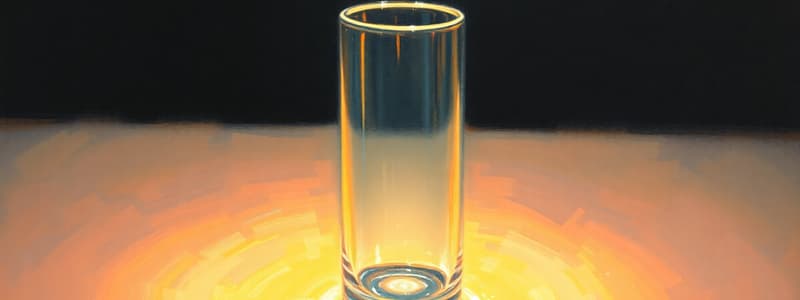Podcast
Questions and Answers
What happens to the light ray after it passes through a rectangular glass slab?
What happens to the light ray after it passes through a rectangular glass slab?
- It exits parallel to the incident ray but is laterally displaced. (correct)
- It is absorbed completely.
- It spreads out in multiple directions.
- It is deviated at an angle.
What is true about the triangular glass prism's lateral surfaces?
What is true about the triangular glass prism's lateral surfaces?
- They are parallel to each other.
- They are all inclined at 90 degrees.
- They are flat and do not refract light.
- They meet at an acute angle, known as the angle of the prism. (correct)
During the refraction activity with the prism, what is the role of the pins fixed at points P and Q?
During the refraction activity with the prism, what is the role of the pins fixed at points P and Q?
- They mark the angle of incidence directly.
- They are used to measure the refractive index.
- They illustrate the displacement of the light ray.
- They serve as reference points for finding the images seen through the prism. (correct)
What technique is employed to visualize the path of light through the prism in the described activity?
What technique is employed to visualize the path of light through the prism in the described activity?
Which of the following statements about eye donation is INCORRECT?
Which of the following statements about eye donation is INCORRECT?
What is the significance of drawing perpendiculars to the refracting surfaces at points E and F during the activity?
What is the significance of drawing perpendiculars to the refracting surfaces at points E and F during the activity?
How many corneal blind individuals can benefit from a single pair of donated eyes?
How many corneal blind individuals can benefit from a single pair of donated eyes?
What is NOT part of the process described for evaluating donated eyes?
What is NOT part of the process described for evaluating donated eyes?
What phenomenon occurs when white light passes through a glass prism?
What phenomenon occurs when white light passes through a glass prism?
What is the angle called that describes how much the emergent ray bends in relation to the incident ray when passing through a prism?
What is the angle called that describes how much the emergent ray bends in relation to the incident ray when passing through a prism?
In which order do the colors appear when white light is dispersed by a prism?
In which order do the colors appear when white light is dispersed by a prism?
When light enters from air into glass at the surface of the prism, what happens to the light ray?
When light enters from air into glass at the surface of the prism, what happens to the light ray?
How does the shape of a prism affect the light passing through it?
How does the shape of a prism affect the light passing through it?
What role does the angle of the prism play in the refraction of light?
What role does the angle of the prism play in the refraction of light?
What occurs when the light exits the second surface of the prism?
What occurs when the light exits the second surface of the prism?
What is the acronym used to remember the sequence of colors produced by the dispersion of white light?
What is the acronym used to remember the sequence of colors produced by the dispersion of white light?
Flashcards are hidden until you start studying
Study Notes
Refraction of Light through Glass Slab and Prism
- Light passing through parallel refracting surfaces like a glass slab emerges parallel but slightly laterally displaced from the incident ray.
- A triangular glass prism consists of two triangular bases and three rectangular lateral surfaces, with an angle between two lateral faces termed the angle of the prism.
Refraction Experiment with a Prism
- Fix white paper and a glass prism on a drawing board to observe light refraction.
- Use pins to indicate points on an incident ray, creating a straight line to trace the path of light through the prism.
- The setup allows measuring angles of incidence, refraction, and emergence at the surfaces of the prism.
Light Dispersion with a Prism
- A narrow beam of white light can be observed dispersing into a spectrum of colors when passing through a glass prism.
- The light entering from air to glass bends towards the normal, while light exiting from glass to air bends away from the normal.
- The unique shape of the prism results in an angle of deviation, which is the angle between the direction of the incident ray and the emergent ray.
Colors of the Rainbow
- When white light passes through a prism, it separates into a spectrum of colors, commonly referenced by the acronym VIBGYOR: Violet, Indigo, Blue, Green, Yellow, Orange, and Red.
- The phenomenon of light dispersion explains the colors observed in a rainbow.
Eye Donation Process
- Eyes must be removed within 4-6 hours post-mortem for donation; the nearest eye bank should be informed promptly.
- Removal process takes 10-15 minutes and is non-disfiguring.
- Certain health conditions prohibit eye donation, but donated eyes are thoroughly evaluated, with unusable ones directed towards research.
- One pair of eyes can restore sight to up to four individuals affected by corneal blindness.
Studying That Suits You
Use AI to generate personalized quizzes and flashcards to suit your learning preferences.




